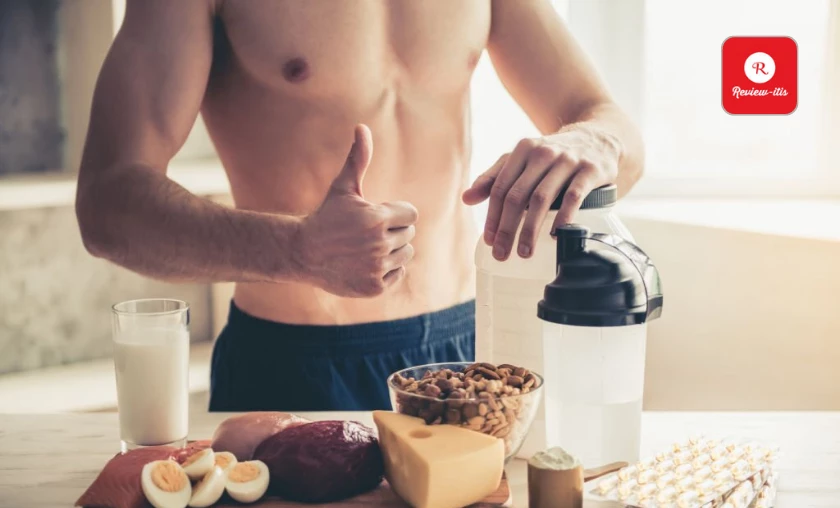Nutrition for CrossFitters. Hey, Friends! You probably want to know about nutrition for crossfitters. So don’t think more, here you will know many answers of your questions…
When crafting your nutrition plan for optimal CrossFit performance, oh boy, there are so many factors to juggle! Trying to figure out where to begin and what deserves your utmost attention can feel overwhelming. But fear not, my friend, for I’m here to break it down for you.
In terms of their impact on your precious body composition, let’s explore the top 5 elements you should consider. Brace yourself; it’s about to get real:
Now, let’s delve into each of these elements and uncover how you can tweak them to unleash your CrossFit prowess and achieve those jaw-dropping results you’ve been yearning for. Are you ready? Let’s dive in!
Table of Contents
Nutrition for CrossFitters: Calories

Let me break it down for you because understanding the right amount of calories to fuel your CrossFit workouts is the absolute game-changer.
Here’s the thing: many people have yet to learn how much they should eat. And guess what? They end up eating too little, which is a total performance killer.
When you don’t fuel yourself adequately, it’s like putting your workouts first and everything else last. Sure, you might feel good during your sessions for a little while, but trust me, other parts of your body will start to suffer.
Think about it: lack of calories means your brain won’t function at its best. Concentration? Say goodbye to it. And ladies, pay attention: irregular or even lost periods might become a sad reality.
Let’s be real here. Over time, your body will struggle to even fuel your workouts properly because it’s simply not getting enough calories. It’s time to put an end to that nonsense and fix it, my friend!
Calculate your calorie needs:

Let’s talk numbers. Calculating the number of calories you need to maintain your weight may seem intimidating, but fear not; Pamela Wilson is here to guide you through it.
First things first: multiply your weight in pounds by 15. This will give you a rough estimate of how many calories you need on a day when you’re doing a moderate training session. You know, the kind that lasts 1-2 hours and includes 10-25 working sets.
If it’s a rest day, subtract 300 calories from that amount. On the other hand, if you’re doing double training sessions and both are moderate, or one is hard, then add 300 calories.
Let’s take an example. Say you’re a female weighing 140 pounds. To maintain your weight, you would need approximately… drumroll, please… 2100 calories on a moderate training day. On a rest day, subtract 300 calories, so that’s 1800 calories. And for a double training day, add 300 calories, which brings us to 2400 calories.
There you have it, my friend. Use these calculations as a starting point and adjust as needed to fuel your body and crush those workouts!
TO MAINTAIN CALORIES
- Rest day: 1800 calories
- Moderate day: 2100 calories
- Hard day: 2400 calories
This would be to Keep calories.
To lose weight, you need to take 500 calories each day, so for our female, that would be:
TO LOSE WEIGHT
- Rest day: 1300 calories
- Moderate day: 1600 calories
- Hard day: 1900 calories
To gain weight, for example, in order to build muscle, you need to add 500 calories to each day:
TO GAIN WEIGHT
- Rest day: 2300 calories
- Moderate day: 2600 calories
- Hard day: 3000 calories
To figure out if you’re getting the right amount of calories, here’s what you should do: weigh yourself every week for three weeks. It’s a simple way to keep track of your progress and see if any adjustments are needed.
When you’re in maintenance mode, listen up: you shouldn’t lose or gain more than 1.25% of your body weight. That’s the magic number. If you find yourself outside that range, it’s time to act.
If you’re losing too much, it’s a sign that you might need to increase your calorie intake. On the flip side, if you’re gaining more than you’d like, it’s time to dial back those calories a bit.
Remember, finding the right calorie balance is an ongoing journey. Stay mindful, keep an eye on your progress, and adjust as needed. You’ve got this, my friend!.
Nutrition for CrossFitters: Macronutrients

So, now that you’ve got a handle on your daily calorie needs, the next step is figuring out how to distribute those calories among carbohydrates, protein, and fat. Trust me, Pamela Wilson has got your back.
Let’s kick things off by shining the spotlight on the superstar macronutrient for CrossFit training: protein. This baby is the real deal when it comes to taking your performance to the next level.
Protein is like the secret weapon that fuels your muscles, aids in their recovery, and helps you build that strong, lean physique you’re after. It’s a game-changer, my friend.
So, here’s the deal: pay close attention to your protein intake. Make sure you’re getting enough of this mighty macronutrient to support your CrossFit endeavors and maximize your gains.
Stay tuned because we’ll be diving into carbohydrates and fats next. Get ready to fine-tune your nutrition game and unleash your full CrossFit potential!
Protein:

Protein is crucial for muscle repair and growth, and without enough of it, your body will break down muscle tissue for energy during workouts. This is why protein is the most important macronutrient for building and maintaining muscle.
For CrossFit athletes and those who practice strength training, the recommended daily intake is 1 gram of protein per pound of body weight.
For our example client who weighs 140 pounds, that would be 140 grams of protein per day. It’s important to note that this protein intake stays the same on training days since protein is essential for building and maintaining muscle.
Carbohydrates:

Let’s talk about the powerhouse macronutrient: carbohydrates. These babies are the fuel for your cells, especially the muscle cells responsible for contraction. And trust me, my friend, that’s a crucial factor when it comes to any exercise, especially the intensity of CrossFit and strength training.
Here’s the good news: having a high carbohydrate intake doesn’t come with any notable downsides as long as you’re also consuming adequate amounts of protein and fat. It’s all about finding that balance, you know?
But here’s where it gets interesting: I recommend adjusting your carbohydrate intake based on your training days. On days when you’re not hitting the gym, you won’t need as many carbs. It’s time to dial it back a bit. On the flip side, on those intense training days, you’re going to need a bit more fuel in the form of carbohydrates to power through those workouts like a beast.
Remember, my friend, finding the right balance of carbohydrates, protein, and fat is key. Tailor your carb intake to match your training schedule, and you’ll be on the path to reaching your CrossFit goals with flying colors!
Here’re the recommendations:
CARBS INTAKE FOR MEN
- Rest: 1g carbs per pound body weight
- Moderate: 1.5g carbs per pound body weight
- Hard: 2g carbs per pound body weight
For our female athlete, this would be:
CARBS INTAKE FOR WOMEN
- Rest: 140g
- Moderate: 210g
- Hard: 280g
Fat:

Let’s pay attention to fats; they deserve it, my friend. They play a crucial role in our overall health by regulating our hormones, which significantly impact various processes within our bodies. It’s safe to say that fats are essential to our well-being.
When it comes to the minimum daily intake of fats for maintaining good health, the recommended amount is 0.3 grams per pound of body weight. In the case of our example client, that would be 42 grams. It’s important to take advantage of this minimum requirement.
However, here’s the interesting part: consuming additional fats beyond the minimum doesn’t offer any added benefits specifically for your training. But here’s where they come in handy—they can help you meet your target calorie intake more easily. Fats are dense in calories compared to protein and carbs, which means they can contribute to reaching your overall calorie goals.
So, my friend, remember to include fats in your nutrition plan, ensuring you meet the minimum requirements. They can be a useful tool in maintaining a balanced diet and assisting you in reaching your calorie targets effectively.
Calories:

- There’re 4 calories in 1 gram of protein
- There’re 4 calories in 1 gram of carbohydrates
- There’re 9 calories in 1 gram of fat
To calculate the amount of fat you can have, first, calculate how many calories are taken up with the protein & carbohydrate recommended amounts, & then divide the remaining calories by 9 to get your recommended grams of fat (which should be above the minimum).
So, for our example client, here’re her goals to maintain weight:
CALORIES
- Rest day: 1800 calories
- Moderate day: 2100 calories
- Hard day: 2400 calories
MACROS
- Rest day: 140g protein, 140g carbs, 76g fat
- Moderate day: 140g protein, 210g carbs, 78g fat
- Hard day: 140g protein, 280g carbs, 80g fat
As long as the fat is at its minimum, it’s possible to eat less fat & more carbs if that’s easier for you to achieve your calorie intake.
Remember, calorie intake is most important & the macro split is second.
Nutrition for CrossFitters: Nutrient timing

The struggle of timing our meals is familiar, especially for those leading active lives.
We’re well aware that fueling up before and after a workout is important, but the details can be elusive. How long before or after should we eat? And what exactly should we be putting on our plates? The burning question remains: Does it truly make a difference?
Now, here’s the truth: If you’ve already mastered the art of consistently meeting your calorie and macronutrient goals, then nutrient timing can positively impact your performance. It’s like adding that extra oomph to elevate your game.
However, let’s not overlook that if your primary needs—adequate calories and macros—are not being met consistently, the effect of nutrient timing becomes smaller. It’s like fine-tuning a well-oiled machine without neglecting the core components, you see?
So, while nutrient timing can certainly play a role in optimizing your performance, let’s remember to prioritize meeting your overall nutritional requirements as the foundation. Once those foundational needs are fulfilled, then we can explore the finer details of nutrient timing to further enhance your performance. Keep up the great work!
Pre-workout:

Ensuring that your body is properly fueled before a workout is crucial for optimal performance, so knowing what and when to eat is important.
It is recommended to consume a medium-sized meal 3-4 hours prior to exercise and a small snack containing protein and fast-digesting carbs 30 minutes before.
If you exercise in the morning, skipping the meal is unavoidable, but having a snack 30 minutes before the workout is still crucial.
Here are some examples of suitable pre-workout snacks:
SNACKS
- Plain Greek yogurt with honey
- Oatmeal with berries
- Apple with almond butter and raisins
- Carbohydrate supplement shake
Intra-workout:

Here’s the game plan: Incorporate fast-digesting carbs along with small portions of fast-digesting protein, such as whey protein. It’s like giving your body that extra boost to sustain your energy levels and support muscle recovery during the workout.
Aim for no more than 5-10% of your daily protein intake and slightly less than your maximum carbohydrate intake per hour to get the balance right. A general guideline is around 0.3g of protein per pound of body weight.
When it comes to longer workouts lasting over an hour, my friend, fueling your body with a combination of carbohydrates and protein during your session can be beneficial.
So, my friend, keep those carbs and protein handy during those longer workouts to help you power through and optimize your performance. It’s all about giving your body the proper nutrients at the right time. You’ve got this!
Post-workout:

After putting in the effort during your workout, my friend, it’s crucial to kickstart the recovery process by nourishing your body with a well-deserved snack or meal.
Here’s the scoop: Your muscles are extra receptive to carbohydrates immediately after exercise. It’s like they’re eagerly waiting to replenish their energy stores. So, this is the perfect time to consume carbohydrates and refuel those hardworking muscles. Remember that this heightened sensitivity gradually diminishes over the next 3-6 hours, so seize the opportunity!
But wait, there’s more! Protein should join the party as well. By pairing protein with carbohydrates, you’re ensuring that the process of muscle repair and recovery gets underway. It’s like providing your body with the building blocks to rebuild and return stronger.
Now, let’s talk about fats. While they’re an important part of our diet, it’s best to keep their consumption to a minimum during this post-workout window. Why? Well, fats have a tendency to slow down the digestion of carbohydrates, and we want those carbs to be readily available to our muscles, right? It’s like removing any obstacles that could hinder the efficient refueling process.
So, my friend, after your workout, prioritize having a snack or meal that combines carbohydrates and protein to optimize your recovery. And remember, keep those fats in check during this particular time. Your body will thank you for it. Keep up the great work!
Before bed:

Getting the proper nutrients before bed can greatly aid in your body’s recovery and preparation for the next day’s activity.
However, eating too close to bedtime or consuming the wrong type of food can lead to stomach problems and disrupt your sleep.
It is worth noting that consuming fats slow down the digestion of protein, which is beneficial overnight; however, it can also result in disrupted sleep, so be mindful of this and pay attention to how your body responds.
I highly recommend a bedtime snack consisting of casein protein with a low-fat or alternative milk, as it provides slow-digesting protein that is perfect for your body’s recovery while you sleep.
Nutrition for CrossFitters: Food composition

Food composition plays a crucial role in determining the quality of the food you consume, my friend.
Imagine having to choose between an apple and a candy bar for your snack. Let’s weigh the options together.
The candy bar may seem enticing and help you meet your daily calorie goals, but those calories come from processed sugars and unhealthy fats that offer little nutritional value.
On the other hand, the apple is a much healthier choice. It contains significantly less fat and provides essential vitamins & minerals that support muscle growth and overall well-being.
Now, let’s dive into selecting high-quality foods for each macronutrient.
Protein is best when it is easily digested by the body, contains all the essential amino acids we need, and is accompanied by beneficial vitamins, minerals, and fiber. It’s all about choosing protein sources that offer a complete package of nutrients.
Remember, my friend, when it comes to food composition, opt for quality over empty calories. Your body will thank you for nourishing it with the proper nutrients and supporting your overall health and fitness goals.
GOOD QUALITY PROTEIN
- High-quality sources of protein include:
- Eggs and egg whites
- Fish
- Lean cuts of meat
- Plain greek yogurt
- Beans and lentils (for plant-based diets)
- Tempeh
Including a variety of protein sources in your daily diet is key. While it’s unnecessary to rely exclusively on the following list every time you consume protein, strive to incorporate at least one of these options into your meals daily. It’s all about embracing the power of variety and enjoying the benefits of a well-rounded protein intake.
Carbohydrates
When it comes to carbs, quality matters. A good quality carb is digested slowly by the body, although there are times when fast-digesting carbs are preferable. It’s also important that the carb is nutrient-dense, providing your body with vitamins and minerals essential for optimal health.
While it’s not necessary to exclusively eat slow-digesting carbs, it’s a good idea to incorporate them into your diet on a regular basis.
High-quality sources of carbohydrates include:
GOOD QUALITY CARBS
- Beans & lentils
- Potatoes
- Fresh & frozen fruit
- Quinoa
- Oats
- Sweet potato
- Whole grain bread
- Whole grain pasta
- Plain yogurt
It’s smart to prioritize including this particular carbohydrate as the mainstay of your diet, especially when you need to be more engaged in your workout sessions. However, when it comes to those intense sweat-inducing sessions, you’ll want to ensure you’re fueling up with fast-digesting carbs for optimal performance.
Examples of these are:
FAT DIGESTING CARBS
- Protein powders
- White rice
- Gatorade
- Potatoes
» Fats
Fat quality is Considered by its type. There are four main types.
» Monounsaturated fat
Consuming the right amount of this specific fat can do wonders for your overall well-being. It’s primarily present in plant-based sources like luscious olive oil or delectable avocados, which makes it even more appealing for your health-conscious journey.
» Polyunsaturated fat
You’ll come across this particular type of fat in various sources, such as vegetable oils, select nuts, fatty fish, and even grass-fed animal meat.
Now, let’s talk about those renowned Omega-3 and Omega-6 fats prominently in fatty fish. These fats are crucial for our well-being; interestingly, many folks tend to unintentionally fall short of their Omega-3 intake. I
It’s important to keep an eye on that and ensure we’re nourishing ourselves adequately with these essential fats.
» Saturated fat
The primary source of this particular type of fat is derived from animal products like meat, eggs, and dairy.
Although it’s advised not to indulge in excessive amounts of this fat, incorporating it in moderation can indeed offer certain benefits. It’s all about finding the right balance and including small portions of this fat in your dietary choices.
» Trans fat
You’ll hardly stumble upon trans fat in its natural form, as it is predominantly generated artificially to enhance the shelf life of certain products. Extensive research indicates that consuming excessive amounts of trans fats is detrimental to our health and can have negative impacts on the body.
As a general rule, it’s advisable to opt for monounsaturated or polyunsaturated fats whenever feasible while incorporating saturated fats in moderation. However, it’s best to steer clear of trans fats as much as possible. Now, let me provide you with a few examples of foods that contain those beneficial, healthy fats:
HEALTHY FATS
- Avocado
- Extra virgin olive oil
- Egg yolks
- Cashews
- Pistachios
- Peanuts (and natural peanut butter)
- Olives
- Seeds such as chia and flax seeds
Nutrition for CrossFitters: Supplements

When it comes to supplements, they should always be the last item on your checklist, following an assessment of whether you’re consuming enough calories, the right proportion of macronutrients, and timing your meals appropriately with quality foods.
Only then can supplements have a noticeable impact on enhancing your CrossFit performance. Although there’s an abundance of supplements on the market, research has demonstrated that only a few of them deliver their advertised benefits.
It’s also important to note that in several countries, including the US, no regulations require supplement manufacturers to substantiate their claims. On the bright side, studies have proven that the following supplements can genuinely boost your performance when used correctly:
PROVEN SUPPLEMENTS
- Caffeine
- Whey protein
- Casein protein
- Creatine
- Carbohydrate formulas
- Multivitamins and minerals
- Omega-3
Conclusion
If you’re looking to enhance your CrossFit performance through proper nutrition, it’s vital to prioritize the five key categories, starting with the most influential one: calories. It’s essential to focus on consuming high-quality food in the appropriate quantities and at the optimal times throughout the day.
By following this approach consistently, you’ll notice significant improvements in overall health and CrossFit performance. Remember to remain committed to these core principles & make them a permanent part of your lifestyle, as consistent effort leads to the most significant gains.
For more amazing articles related to Health, Checkout Now with a click
To read more similar articles, click here.
Thanks for visiting our Website. If you appreciate our work, kindly show us some support in our comments section. 🙂